Citrix Provisioning™ managed by Citrix Cloud
Citrix Provisioning supports Citrix Cloud integration. It enables provisioned VDAs to be used in the Citrix Virtual Apps and Desktops.
Important considerations:
- You must use an on-premises Citrix Virtual Apps and Desktops license to serve cloud based licenses. If you are using an earlier Citrix Provisioning version, prior to 7.18, you must continue to host the on-premises Citrix License server in addition to using either a Citrix Provisioning Enterprise or Platinum license version.
- Configure the Citrix Provisioning console (or use associated PowerShell commands) to use the Citrix Cloud™ license.
Check your on-premises Citrix Licensing server and ensure you are using either a Citrix Provisioning Enterprise or Platinum license version.
What’s required
The following elements are required when using Citrix Provisioning with Citrix Cloud:
- Citrix Virtual Apps and Desktops Delivery Controller in Citrix Cloud: Citrix Virtual Apps and Desktops builds a version of the Citrix Provisioning PowerShell snap-in (Citrix.PVS.snapin) with a subset of the Citrix Provisioning on-premises cmdlet. This version is built specifically to run in Citrix Cloud and communicate with Citrix Provisioning on-premises through the Citrix Cloud Connector.
- Citrix Cloud Connector™ located on-premises: The Cloud Connector provides services for the Citrix Cloud Delivery Controllers to configure the resource location where Citrix Provisioning runs.
- Provisioning Server located in the resource location where Citrix Provisioning targets must run: Citrix Provisioning server must be 1912 LTSR or later for on-premises, 2203 LTSR or later for Citrix Provisioning on Azure, and 2206 or later for Citrix Provisioning on GCP.
- Citrix Virtual Apps and Desktops Remote PowerShell SDK: The Provisioning Console installation includes the Citrix Virtual Apps and Desktops SDK. The Citrix Virtual Apps and Desktops Remote PowerShell SDK replaces the Citrix Virtual Apps and Desktops SDK. The SDK is used by the Citrix Virtual Apps and Desktops Setup Wizard to push VDA records to the Delivery Controller in Citrix Cloud.
- The Licensing Server must be on-premises: For Citrix Provisioning deployments, the Citrix License Server must be on-premises.
When using the Citrix Cloud feature, consider the following:
- To install the remote PowerShell SDK on the provisioning server, uninstall the 5 Citrix Virtual Apps and Desktops snap-ins from the server, then install the remote PowerShell SDK.
- Once a Citrix Provisioning console is installed with the remote PowerShell SDK and is used for provisioning, it no longer functions with on-premises Citrix Virtual Apps and Desktops.
- Do not install Citrix Provisioning on the Delivery Controller™ or the machine on which Citrix Studio is installed.
- In the Citrix Virtual Apps and Desktops Setup Wizard, enter the IP address for the Citrix Cloud Connector when it prompts for the controller address.
Dependencies
The following dependencies exist when using Citrix Provisioning and Citrix Cloud:
- Citrix Studio
- Citrix Cloud Connector, with the Remote Broker Provider (XaXdCloudProxy)
- Citrix Virtual Apps and Desktops Remote PowerShell SDK
On-premises versus Citrix Cloud deployments
Traditional Citrix Virtual Apps and Desktops deployments using Citrix Provisioning require the management of two distinct elements: both the Citrix Virtual Apps and Desktops deployment and the Citrix Provisioning deployment. Such environments resemble the following image, without the added complexity of illustrating VDA components:

With an on-premises Citrix Provisioning deployment, the Citrix Virtual Apps and Desktops have been extended:
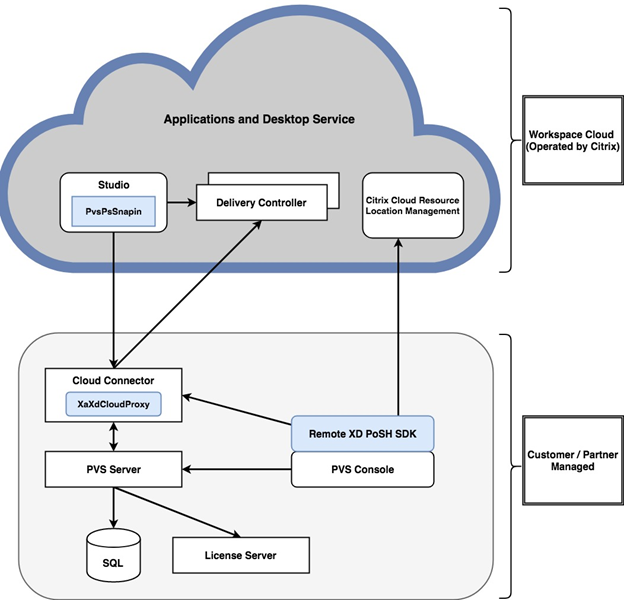
Extending the Citrix Virtual Apps and Desktops deployment eliminates the need to operate and manage the deployment while still providing the benefits of a managed Citrix Provisioning deployment.
Citrix Provisioning adds provisioning managed VDAs to a machine catalog in the Citrix Virtual Apps and Desktops Delivery Controller located in Citrix Cloud. This process uses one of two methods:
- Add new devices using the Citrix Virtual Apps and Desktops Setup Wizard in the provisioning console.
- Import existing Citrix Provisioning devices using the machine catalog creation wizard in Citrix Studio.
Citrix Virtual Apps and Desktops Setup wizard in the Citrix Provisioning console
The Citrix Virtual Apps and Desktops Setup Wizard enables you to create Citrix Provisioning devices and collections, and then create machine catalogs containing these elements. The Citrix Virtual Apps and Desktops SDK must be replaced with the Citrix Virtual Apps and Desktops Remote PowerShell SDK. This Remote PowerShell SDK is responsible for communicating with the Delivery Controller.
Machine catalog setup wizard using studio
The machine catalog setup wizard imports existing provisioned-managed VMs to a Citrix Virtual Apps and Desktops catalog. In cases such as these, the VMs must be previously created using the provisioning console. Consider:
-
Studio uses the PowerShell snap-in PvsPsSnapin to communicate with the provisioning server. The PvsPsSnapin is a subset of the existing Citrix Provisioning PowerShell snap-in, Citrix.PVS.Snapin. It contains the following cmdlets:
-
Clear-PvsConnection
-
Get-PvsVersion
-
Get-SimplePvsADAccount
-
Get-SimplePvsCollection
-
Get-SimplePvsDevice
-
Get-SimpleDiskLocator
-
Get-SimpleDiskUpdateDevice
-
Get-SimplePvsSite
-
Get-SimplePvsUpdateTask
-
Set-PvsConnection
Note:
In Citrix Cloud, PvsPsSnapin has been extended. This snap-in enables communication from the Citrix Virtual Apps and Desktops to the PvsMapiProxyPlugin, a newly created proxy added to XaXdCloudProxy in the Cloud Connector.
Communication is over a secure channel, HTTPS port 443, including Citrix Provisioning administrator credentials. These credentials are used by the proxy to impersonate the administrator before contacting the Provisioning Server.
Connecting your Citrix Provisioning deployment to the Citrix Virtual Apps and Desktops in Citrix Cloud
To connect an existing Citrix Provisioning deployment to Citrix Cloud:
- Upgrade Citrix Provisioning. You must use the latest version. See the download page.
-
Replace the Citrix Virtual Apps and Desktops SDK on your Citrix Provisioning console with the Citrix Virtual Apps and Desktops Remote PowerShell SDK.
When installing this SDK, the Provisioning Console on which this functionality is installed does not communicate with local Citrix Virtual Apps and Desktops deployments. This functionality also applies to the provisioning server. Communication exists only to the Citrix Cloud. Devices managed by the Delivery Controller in Citrix Cloud update their virtual disk images and VDAs to use the Delivery Controller to register with Citrix Virtual Apps and Desktops.
Important:
An on-premises Citrix License Server is required in the Citrix Virtual Apps and Desktops Service deployment. See the Licensing page for more information.
Upgrade Citrix Provisioning
To use Citrix Cloud with Citrix Provisioning, you must use a version that integrates with the Citrix Virtual Apps and Desktops. The Citrix Provisioning server must be 1912 LTSR or later for on-premises, 2203 LTSR or later for Citrix Provisioning on Azure, and 2206 or later for Citrix Provisioning on GCP. The recommended version is the latest CU of one of the LTSRs: 1912 or 2203, or latest CR.
Using the Citrix Virtual Apps and Desktops remote PowerShell SDK
The Provisioning Console component includes the Citrix Virtual Apps and Desktops SDK; this SDK must be replaced with the Citrix Virtual Apps and Desktops Remote PowerShell SDK.
To use the new SDK
- Uninstall the Citrix Virtual Apps and Desktops SDK from the Provisioning Console by removing the following snap-ins:
- Citrix Broker PowerShell snap-in
- Citrix Configuration Logging Service PowerShell snap-in
- Citrix Configuration Service PowerShell snap-in
- Citrix Delegated Administration Service PowerShell snap-in
- Citrix Host Service PowerShell snap-in
- Download the Remote PowerShell SDK from the Downloads page. PowerShell 3.0 is required to be pre-installed.
-
Install the SDK using the command to execute:
CitrixPoshSdk.exe PVS=YES. See SDKs and APIs for more information.Important:
Install the downloaded SDK from the command line, and include the argument “PVS=YES.”


To verify the new SDK installation
- Open PowerShell.
- Execute the cmdlet: Add-PsSnapin Citrix*.
- Execute the cmdlet: Get-BrokerServiceStatus.
- Sign in to Citrix Cloud.
Tip:
The
Get-BrokerServiceStatuscmdlet indicates that the Delivery Controller is OK.

Firewall considerations
Firewall configurations typically require zero or minimal updates. Consider the following:
- On the Provisioning Console, outward bound SDK traffic uses HTTPS (port 443).
- On the Cloud Connector machine, all traffic is outbound to the cloud over HTTPS (port 443). This process enables the connector and Console to reside behind NATs and HTTP proxies.
- The new Citrix Provisioning proxy added to the Cloud Connector forwards HTTP (port 80) communications to the Provisioning Server, using wsHttp message security.
Note:
Personal vDisk functionality is not supported.
Administer VDAs
To add Citrix Provisioning managed VDAs to a machine catalog
- Use the Citrix Virtual Apps and Desktops Setup Wizard in the provisioning console, or;
- Use the machine catalog setup wizard in Citrix Studio
Using the Citrix Virtual Apps and Desktops Setup wizard to add VDAs
The Citrix Virtual Apps and Desktops Setup Wizard creates Citrix Provisioning devices and collections, then creates machine catalogs containing these elements. The Wizard prompts for the Citrix Virtual Apps and Desktops Controller address.
-
Provide the address of one of the Cloud Connector machines (rather than the Controller address).
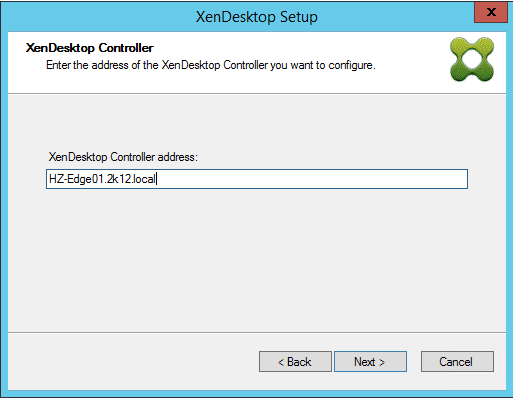
-
After entering the address of the Cloud Connector, click Next.
The Citrix Cloud authentication screen appears, prompting for sign-in credentials. This prompt is generated by the Citrix Virtual Apps and Desktops Remote PowerShell SDK and is cited by the Provisioning Console.
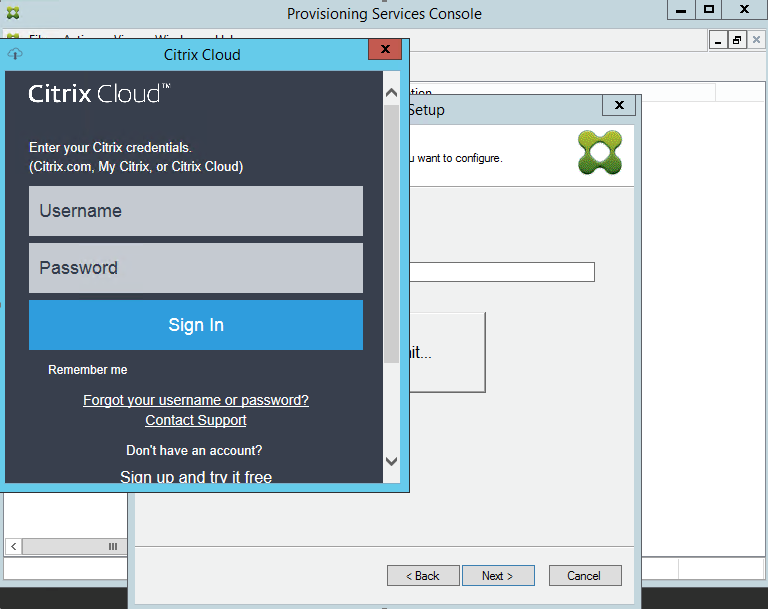
Tip:
The Citrix Cloud credentials enable the SDK to securely communicate with the Citrix Virtual Apps and Desktops to configure the machine catalogs. The remaining steps in the Citrix Virtual Apps and Desktops Setup Wizard are unchanged. The only difference is the prompt for the Citrix Cloud sign-in credentials when the wizard first invokes the cmdlet in the Remote PowerShell SDK.
Using the machine catalog setup wizard to add VDAs
This Citrix Studio wizard adds existing managed Citrix Provisioning VMs to a catalog. In this scenario, the VMs were previously created using the Provisioning Console. The Stream and SOAP Services user account must have View Database State permission to obtain the Provisioning Server version for the connected MAPI server. This implementation is used to verify that the database is a Provisioning Server database.
To use this wizard
- Access Citrix Studio from the Manage tab of the Citrix Virtual Apps and Desktops page.
- Select Machine Catalogs in the navigation pane.
- Click Create New Catalog in the Actions pane.
-
Select Citrix Provisioning, and click Next.
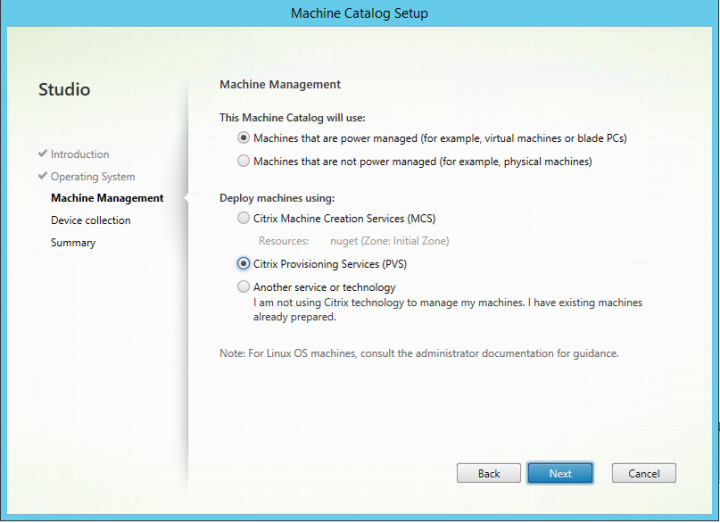
-
On the Device Collection page, provide the address of the Citrix Provisioning server and click Connect.
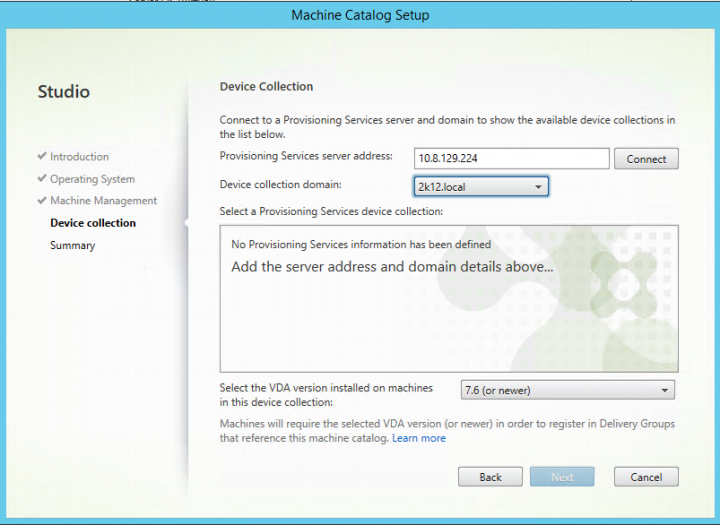
-
Provide the login credentials for the Citrix Provisioning administrator and click OK.
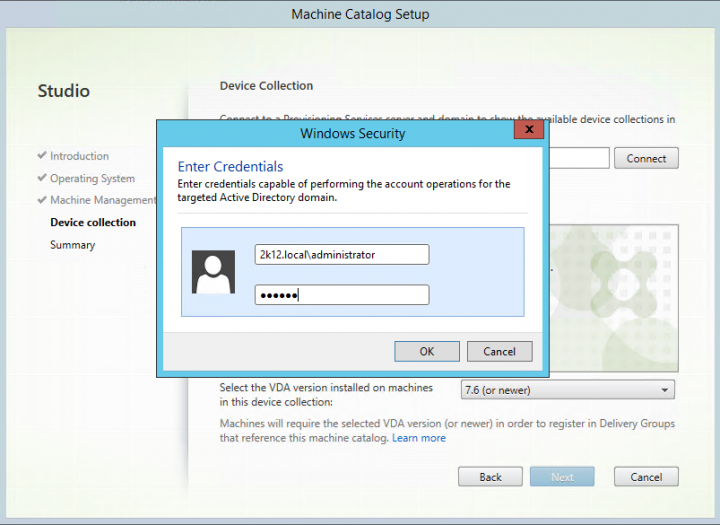
After entering the login credentials, Studio communicates with the Cloud Connector, which then forwards requests to the provisioning server using the specified credentials. If a valid Citrix Provisioning administrator is provided, device collections are displayed.

This authentication method represents the only difference between an on-premises Citrix Virtual Apps and Desktops deployment and a Citrix Virtual Apps and Desktops deployment in Citrix Cloud. In an on-premises case, the identity of the Citrix Studio user authenticates to the provisioning server. In the service model, an explicit authentication is required because Studio runs in an AD environment with no trust relationships to the AD of the Citrix Provisioning deployment.
Error messages in studio
When setting up a machine catalog using the wizard, the Device Collection screen displays the state of Citrix Provisioning cloud connection. If the feature has not been enabled, an error message appears, indicating that “Citrix Provisioning for Cloud feature is not enabled.”

Troubleshooting the Citrix Provisioning cloud connector
Use the information in this section to troubleshoot issues related to using the Citrix Virtual Apps and Desktops Setup Wizard for Delivery Controller connectivity.
To verify connectivity
- Ensure that the Remote PowerShell SDK is installed and properly configured. Verify that the Remote PowerShell SDK is installed by executing the following command: CitrixPoshSdk.exe PVS=YES.
- Uninstall the 5 Citrix Virtual Apps and Desktops snap-ins from the Citrix Provisioning Server and Console.
- Ensure that the Citrix Provisioning account is also a member of the local Citrix Provisioning OS Admin group.
Tip:
To install the remote PowerShell SDK on the Provisioning Server, you must uninstall the 5 Citrix Virtual Apps and Desktops snap-ins, then install the remote PowerShell SDK.
Connection problems between the provisioning server and the delivery controller
Use the information in this section to troubleshoot connectivity problems between the Delivery Controller and the Provisioning Server.
To verify connectivity:
-
In Citrix Studio, ensure that the Zones screen properly displays the Cloud Connectors.
-
Verify that at least one Cloud Connector is “Connected:”
- Sign in to
https://citrix.cloud.com. - Under Resource locations > Your Resource Location > Cloud Connectors, verify that at least one Cloud Connector is showing status as Green.
- Sign in to
-
Verify that the Citrix Remote Broker Provider is up and running in the Cloud Connector. See the Cloud Connector to see if the Citrix Remote Broker Provider Service is running.
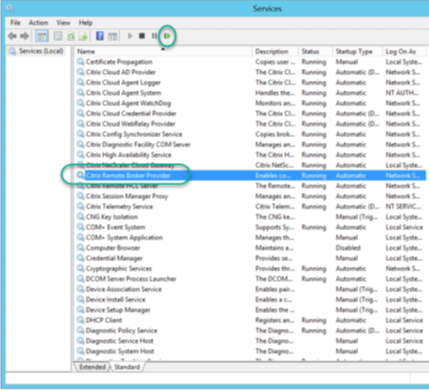
Considerations when using the Machine Creation Services™ (MCS) wizard
Use the information in this section when using the MCS wizard in Citrix Studio to import Citrix Provisioning devices into Citrix Virtual Apps and Desktops devices. Verify that:
- Citrix Provisioning devices exist in the collection.
- All target devices are joined to the domain at the same OU.
- A host record of the hypervisor environment where on-prem VMs are located is created in Citrix Virtual Apps and Desktops.
- The correct domain is chosen before the client’s domain. This process must occur before connecting to the provisioning server in the wizard.
In this article
- What’s required
- Dependencies
- On-premises versus Citrix Cloud deployments
- Citrix Virtual Apps and Desktops Setup wizard in the Citrix Provisioning console
- Machine catalog setup wizard using studio
- Connecting your Citrix Provisioning deployment to the Citrix Virtual Apps and Desktops in Citrix Cloud
- Upgrade Citrix Provisioning
- Using the Citrix Virtual Apps and Desktops remote PowerShell SDK
- Firewall considerations
- Administer VDAs
- Using the Citrix Virtual Apps and Desktops Setup wizard to add VDAs
- Using the machine catalog setup wizard to add VDAs
- Error messages in studio
- Troubleshooting the Citrix Provisioning cloud connector
- Considerations when using the Machine Creation Services™ (MCS) wizard